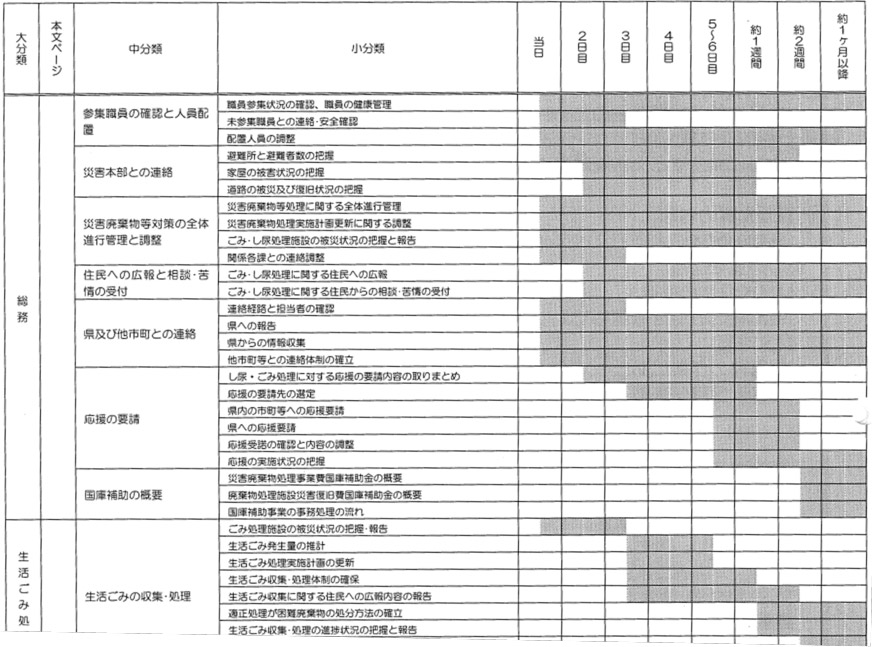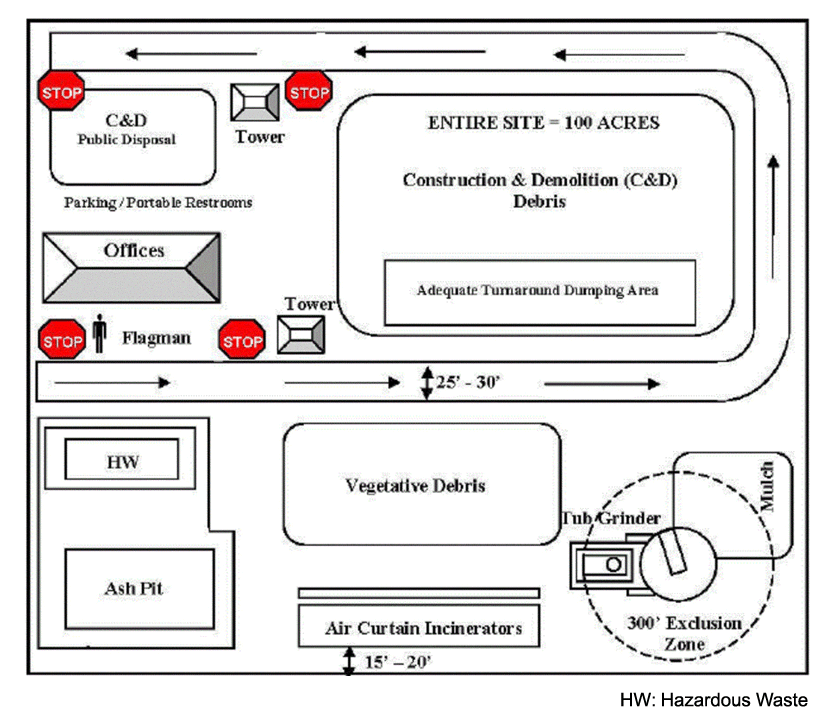- Waste management in Japan
- Circular economy in Japan
- Waste management in Asia
- Disaster waste management
How to Develop a Disaster Waste Management Plan to Enhance Preparedness
What is a Disaster Waste Management (DWM) Plan?
In an emergency situation, we are likely to face difficulties in performing even simple and routine tasks. When a severe natural disaster such as the Tohoku Earthquake in 2011 occurs, municipal governments themselves may be affected while they have the primary responsibility for managing disaster waste (DW). Even under these difficult conditions, they have to carry out operations which are much more challenging than in normal times. Since those municipalities come under intense pressure to achieve quick recovery and reconstruction, they have little time to spare in deciding which DW treatment method to use. For these reasons, it is important to review appropriate DWM procedures during normal times when necessary resources such as personnel, time and data can be secured relatively easily.
DWM Plans, that are developed in advance of disasters, set out DWM procedures in an emergency. Japan's national DWM Guidelines (in Japanese, external link) stipulate that prefectural and municipal governments are required to develop their own DWM Plans to prepare themselves for future disasters. In the event of a disaster, those local governments are expected to implement their DWM Plans for the removal, temporary storage, intermediate treatment and final disposal of DW, while making necessary changes to the plans. DWM Plans indicate the basic policy, institutional and organizational framework, separation and treatment flow, and environmental protection measures for managing specific amount of DW that is estimated from the predicted damage (see related information in the April 2014 issue [in Japanese]). DWM Plans also contain indicative list of tasks, resources and methods for implementation, such as mobilization and deployment of human resources, budget, facilities, equipment, materials and information. Furthermore, DWM Plans have a workflow diagram showing necessary DWM tasks in chronological order (Fig.1), a diagram showing the basic layout of temporary storage sites (Fig.2), and administrative procedures for subsidy applications for DWM.


In the meantime, some said that DWM Plans had not been much help in the management of DW from the Tohoku Earthquake. One reason may be that the DWM Plans had not been thought-out carefully beforehand. In fact, many municipalities had a very simple DWM Plan of no more than one or two pages as part of their overall disaster management plan. The relevant section merely mentioned general and abstract DWM measures. Another reason may be that the DW from the Tohoku Earthquake far exceeded the estimated types and volume of DW. As a result, the DWM strategies that had been made using the same prior estimation were no longer applicable. For example, most municipal governments failed to anticipate the generation of a large amount of DW in the aftermath of the large-scale tsunami.
So, is it necessary to develop a highly-refined DWM Plan after making flawless predictions on those "unexpected events"? How can we make a plan that will be truly useful for DWM when a disaster strikes?
Key points in DWM planning
Only a small number of DWM studies have been conducted in Japan and abroad so far, and accumulation of knowledge is limited in this field. Nevertheless, we have reviewed those existing studies on emergency planning to find some key points in developing a DWM Plan. The results of the review as well as the findings from our interview surveys suggest that there are six important points in DWM planning (Table 1).
| (1) | Focus on learning process through DWM planning rather than the planning document itself. |
|---|---|
| (2) | Coordinate with relevant stakeholders and strengthen collaborative relationship with them in DWM planning. |
| (3) | Focus on basic principles rather than on procedural details so as to be able to respond to disasters with flexibility. |
| (4) | Develop DWM Plans based on an accurate knowledge about disasters and human society that will respond to disasters. |
| (5) | Consider "sustainable" response measures to disasters. |
| (6) | Make DWM Plans applicable to the entire disaster management cycle. |
Among those six items above, the first two items (1 and 2) pertain to DWM planning process. In addition to the development of DWM Plans, enhancement of knowledge and skills of the municipal government officials through DWM planning is important. For instance, their acquisition of DW estimation skills during the DWM planning phase will help them to review and adjust the estimated DW amount after the disaster. Another important aspect is the coordination and collaboration across various divisions in the municipal government. The environment division needs to coordinate in DWM with the civil engineering division, the agriculture, forestry and fisheries division, and other divisions. Since the officials from these different divisions may not actively communicate each other during normal times due to sectionalism, their cross-sectional interaction during the DWM planning phase will facilitate their coordination at the time of a disaster. To give a specific example, when a disaster occurs, the environment division needs to identify temporary storage sites for DW while the civil engineering division needs to secure sites to build temporary housing for evacuees. The communication and coordination between the two divisions, prior to the disaster, will facilitate the identification of appropriate sites for their respective purposes at the time when available land may be limited under such a circumstance.
The other four items pertain to the content of DWM Plans. They are all important, but from the perspective of making a "practical" plan, the third item (3) is particularly important. DWM plans require as much flexibility as possible rather than getting caught up with a specific damage scenario. For example, the plan needs to provide basic general information; a list of private-sector operators who are expected to be actively engaged in DWM; a list of potential sites for temporary storage and treatment of DW; and a checklist of necessary administrative procedures. They are all expected to be useful regardless of the scale of disaster. However, if DWM Plans lack flexibility and provide too many specific details, such documents may become too long to use and review. The plans may even become useless if the actual damage turns out to be largely different from the predicted one.
Moreover, the following aspects relating to the items 4 through 6 are also important in DWM planning; (4) The most advanced scientific knowledge about disasters and human behavior should be considered; (5) Fully consider, in advance, DWM's impact on the local environment and community from a long-term perspective; (6) Consider the entire disaster management cycle across its phases including the phases of initial response, recovery, reconstruction up to the phase of post-disaster efforts of disaster risk reduction and enhancing preparedness for future disaster risks. Once a disaster occurs, the above-mentioned aspects are less likely to be considered. Therefore, these items require a detailed review in advance.
What shall we do with DWM Plans?
Even if we have finally developed a DWM Plan after having considered all the points mentioned above, we do not know when a disaster will occur. The plan may become useless if it is already outdated at the time of the occurrence of the disaster. In addition, there is a concern that one-time-only review of the DWM Plan during the planning phase may not be enough to make the plan complete. Furthermore, reassignment of government officials every two or three years, which is common in Japan, may pose a risk that the plan will be forgotten. This means that DWM Plans need to be periodically reviewed and updated.
When a disaster occurs, DWM Plans should be adjusted based on the actual damage so that they will be made operational. The estimated figure of DW generation often changes as actual data comes in. A new and unexpected problem may also arise as DW treatment progresses. Therefore, any plans including DWM Plans, facing difficulties in making realistic operational assumptions in advance, will require frequent reviews and changes according to the real situation. Those who implement DWM Plans should focus on achieving their primary objective of completing DW treatment, rather than strictly implementing all the activities as per the original plan.
Despite the importance of DWM planning, many municipalities in Japan lack human resources, time and budget for making the plan. According to the statistics of the Ministry of the Environment of Japan (in Japanese, external link), 870 municipalities, nearly half of the total 1,742 municipalities across Japan, assign only one or two officials to waste management. Many of these officials are presumably assigned with various other tasks in addition to DWM. In order to enhance Japan's disaster-preparedness as a whole, continued support to these municipalities from the national government, prefectural governments and any other institutions with relevant expertise is crucial. For example, the Tokyo Metropolitan Government organizes workshops (in Japanese, external link) for the benefit of officials from the cities, towns and villages in its jurisdiction. It is hoped that similar initiatives will be taken across the country. From the viewpoint of building and maintaining good relationships, long-term assistance, that is not limited to a single event, should be provided. Likewise, it is also important to provide specific opportunities for the officials of relevant organizations to interact in their everyday work. NIES will advance research activities that can feed into such assistance.
References
- Kumano City (2010) Kumano City Disaster Waste Treatment Plan (in Japanese)
- Seattle Urban Area Security Initiative Region (2010) Disaster Debris Management Plan
For more information
Tajima R., Hirayama N., Osako M. (2013) Theory and Practice of Pre-Disaster Planning for Disaster Waste Management. Proceedings of the 9th International Symposium on Social Management Systems SSMS2013, SMS13-4303


